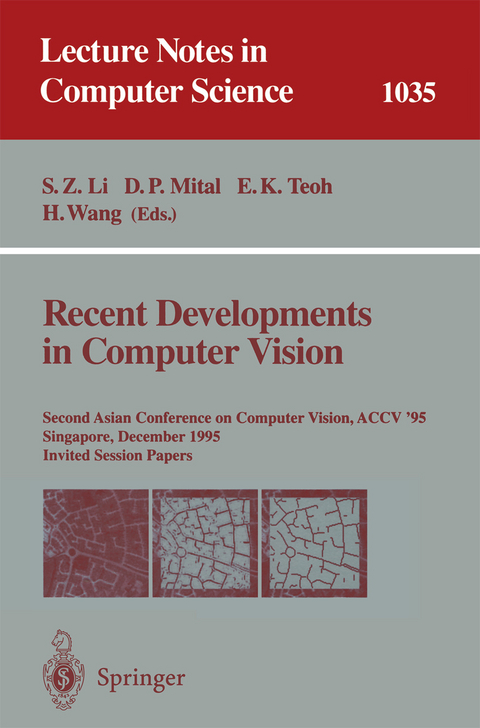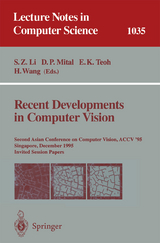Recent Developments in Computer Vision
Springer Berlin (Verlag)
978-3-540-60793-9 (ISBN)
The fifteen leading researchers acting as session organizers at the ACCV '95 solicited and reviewed a unique collection of 56 invited papers presented in this volume. Together, these papers competently reflect the state-of-the-art developments in computer vision and image processing; the author index of the volume reads like a who-is-who in the field. The papers are devoted to both theoretical and practical issues relevant to researchers and professionals in the area.
Digital libraries: Meeting place for high-level and low-level vision.- Computer vision in next generation image and video coding.- Video annotation: Computers watching video.- Video representations.- Analysis of left ventricular motion.- Applications of computer vision in space robotics.- Optical-flow estimation while preserving its discontinuities: A variational approach.- Space- and time-variant estimation approaches and the segmentation of the resulting optical flow fields.- Combining the hough transform and multiresolution MRF's for the robust motion estimation.- Direct model-based image motion segmentation for dynamic scene analysis.- Modeling structured environments using robot vision.- Design trade-offs for real-time block-matching motion estimation algorithms.- Pixel matching and motion segmentation in image sequences.- On the motion problem of a rigid planar patch and its invariance.- Virtual space teleconferencing: Real-time detection and reproduction of 3D face and body images.- High-performance tracking with TRICLOPS.- Developing an active observer.- Active stereo vision system with foveated wide angle lenses.- A control theoretical approach to active vision.- Active rangefinding and recognition with Cubicscope.- Real-time vision is not frame-rate image analysis.- Active vision based stereo vision.- Motion of a stereo rig: Strong, weak and self calibration.- Color stereo vision: Use of appearance constraint and epipolar geometry for feature matching.- Unifying stereo, motion and object recognition via epipolar geometry.- Constructing a visual memory in terms of uniqueness.- Statistical models & algorithms for tomography.- Shape statistics and image analysis.- Cluster Monte Carlo algorithms and their applications.- Gibbs sampler and maximum likelihood estimation for unsupervised image segmentations.- Lane boundary detection using deformable templates: Effects of image subsampling on detected lane edges.- Clique finding relaxation labeling networks.- Rectifying structural matching errors.- Parallel distributed relaxation labeling.- Subgraph isomorphism detection in polynomial time on preprocessed model graphs.- Line postprocessing using probabilistic relaxation and relative measurements.- Multiple-view geometry and photometry.- Euclidean 3D reconstruction from stereo sequences with variable focal lengths.- Characterizing the stability of 3D invariants derived from 3D translational symmetry.- MORSE: An architecture for 3D object recognition based on invariants.- Finding human faces with a Gaussian mixture distribution-based face model.- Handwriting recognition.- An integrated model for evaluating the amount of data required for reliable recognition.- 3D object recognition using bidirectional modular networks.- A region extension method for natural outdoor scene interpretation.- Image processing techniques for crowd density estimation using a reference image.- Autonomous road vehicle guidance in normal traffic.- Evaluation of image sequences from outdoor scenes: Selected problems and solutions.- Vehicle localisation and discrimination in outdoor traffic scenes.- SWIM: A prototype environment for visual media retrieval.- Video segment indexing through classification and interactive view-based query.- View-based techniques for searching for objects and textures.- Graph grammar based object recognition for image retrieval.- Similarity matching.- A document image analysis and recognition system for Japanese family registration.- Applying handwriting recognition to US census forms.
| Erscheint lt. Verlag | 24.1.1996 |
|---|---|
| Reihe/Serie | Lecture Notes in Computer Science |
| Zusatzinfo | XII, 612 p. |
| Verlagsort | Berlin |
| Sprache | englisch |
| Maße | 156 x 234 mm |
| Gewicht | 940 g |
| Themenwelt | Informatik ► Grafik / Design ► Digitale Bildverarbeitung |
| Informatik ► Theorie / Studium ► Künstliche Intelligenz / Robotik | |
| Schlagworte | algorithms • Bewegungsabschätzung • Bildanalyse • Bildanalyse (EDV) • computer vision • Epipolar Geometry • Geometric Invariance • geometrische Invarianz • Hough Transform • Image Analysis • Image Processing • Image Segmentation • Motion Estimation • Object recognition • Objekterkennung • optical flow • Performance |
| ISBN-10 | 3-540-60793-5 / 3540607935 |
| ISBN-13 | 978-3-540-60793-9 / 9783540607939 |
| Zustand | Neuware |
| Informationen gemäß Produktsicherheitsverordnung (GPSR) | |
| Haben Sie eine Frage zum Produkt? |
aus dem Bereich




